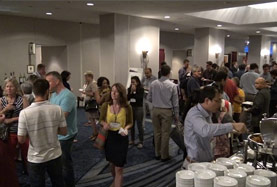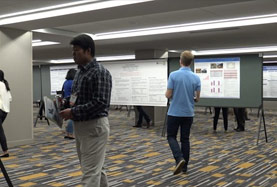

Organized Symposium sessions highlight ideas or works-in-progress on a topic involving cooperative or competing efforts by two or more panelists. Symposia may involve panel discussions of prepared questions, debates, roundtable meetings, or other formats. Formal paper presentations are discouraged, nonetheless if such presentations are proposed, the organizer should explain how they will fit into a tightly coherent theme. At least half of the session time will be reserved for discussion among the panelists and between the panelists and the audience. Symposia may offer discussions of policy issues, research methods, emerging research results, teaching or outreach topics, issues in professional organization, or other matters.
Organized Symposia are concurrent sessions. Each concurrent session is 90 minutes in duration. Other concurrent sessions include, Selected Paper Sessions, Lightning Sessions, Organized Symposia, Track Sessions, Invited Paper Sessions, and Invited Case Study Sessions.
The following nine titles and descriptions are symposia which will be hosted throughout the AAEA 2017 Annual Meeting.
The feasibility of increasing biofuel mandate levels as a means towards reduced transportation sector emissions has been put into question by a lack of sufficient ethanol demand side infrastructure. How important are the required investments from a social welfare perspective and who should be required to make them? This session analyzes the ethanol blend wall from three perspectives: the dynamic aspects that contribute to its existence, its short term impacts which disproportionally affect consumers of diesel fuels, and the environmental and welfare gains that lie beyond.
This symposium will announce the release of a new ERS data application, Linkages, which links retail and household scanner data to the USDA nutrition databases, including the data needed to estimate the Healthy Eating Index (HEI) for food purchases and sales. Linkages allows researchers to examine economic questions related to the healthfulness of foods sold by stores and purchased by consumers, policy questions related to food availability and labeling, and methodological questions related to nutrition research. Three policy research questions that could not be addressed previously will be used to demonstrate the power of Linkages. The symposium will include time for attendees to ask questions and learn how to gain access to the data.
Climate Smart Agriculture is an approach to guide the management of agriculture in the era of climate change. It was launched in 2009 and it is being reshaped to better provide policy design support and recommendations by multilateral organizations. The framework aims to develop strategies to achieve food security and sustainable development, in developed, and in particular developing, countries. This special session will provide the highlights and lead to a discussion on the findings of a recent FAO book on the economics of CSA (“Climate Smart Agriculture - Building Resilience to Climate Change”). The book contains the results of a major policy research effort. It lays a conceptual foundation for CSA as well as 15 case studies on various aspects associated with its implementation and insights by seven leading policy makers and experts. After a five minute introduction, the session will have five presentations of twelve minutes each, followed by a discussion.
The proposed session is organized on crop insurance and risk management for specialty crops with the national perspective. The symposium will feature presentations from three research teams contributing to a coordinated effort to learn about how crop insurance availability and pricing (subsidy) has affected crop mix. This session helps inform the debate and bring about new insights on the role of federal crop insurance as a risk management tool for specialty crop producers.
The status of the debate over the next farm bill is discussed. A unique approach to an AAEA symposium is proposed to accommodate the breadth of this legislation. Eleven 1-page update papers will be posted to the farmdoc website at the University of Illinois at Urbana-Champaign. These papers will be briefly summarized by the moderator, followed by discussion from the audience.
This symposium discusses alternative methodologies for empirically estimating the impacts of weather on agricultural production. It presents emerging research from a quasi-meta-analysis of crop production using different measures of weather (temperature, rainfall, NDVI, soil moisture), with different geospatial data sources (CHIRPS, ARC2, GLDAS, ECMWF, etc.), different weather metrics (max/min, average, variance, onset), in different developing contexts (Ethiopia, India, Kenya, Nicaragua, Uganda, and Zimbabwe). The goal is to provide evidence on the impact weather has on household crop production and how sensitive that impact is to decisions regarding type, source, metric, combination, and crop and country context.
Marijuana policy is a growing topic of discussion among economists. Marijuana laws across the US have been shifting toward legalization. The recent California vote on Proposition 64 (vote on legalization of adult use marijuana) splits legal marijuana sales into two segments, adult-use and medical. California was the first state to allow medicinal marijuana use 20 years ago. Since then, medical use of marijuana has been legal in California, but with no regulations. Beginning in January 1, 2018, these two, medical and adult-use segments of the California marijuana industry will be regulated in every aspect, from cultivation to retail. This proposed session focuses on how the segments of the California marijuana market adjust in response to the recent legalization and the implementation of regulations.
A great deal of attention has been given to the implications of 'big ag data'. This has the potential to change many aspects of farm and environmental management, federal data collection, and reports. It also affords opportunities for new research in consumer demand, traceability, and sustainability monitoring. This session would follow on last year’s pre-conference and the C-FARE white paper on the topic. The intent of the symposium is to take the discussion of big data in our profession to the next level of detail.
Hard Red Winter (HRW) wheat cash prices are over one dollar less than futures at delivery elevators. Producers have no right to deliver against short positions and that should affect their marketing strategies. The futures are not wheat, but wheat warehouse receipts, which are not freely issued to farmers. Those warehouse receipts currently have more value than wheat and prevents arbitrage, and therefore convergence from occurring.







Become a Sponsor or Exhibitor for #AAEAChicago17 - Learn how